MEMBER LOG IN
Categories
Links
Author Archives: ITPA admin
A Biomechanical Analysis of Abdominal Injury in tennis serves; A Case Report. (Tubez et al, 2010).
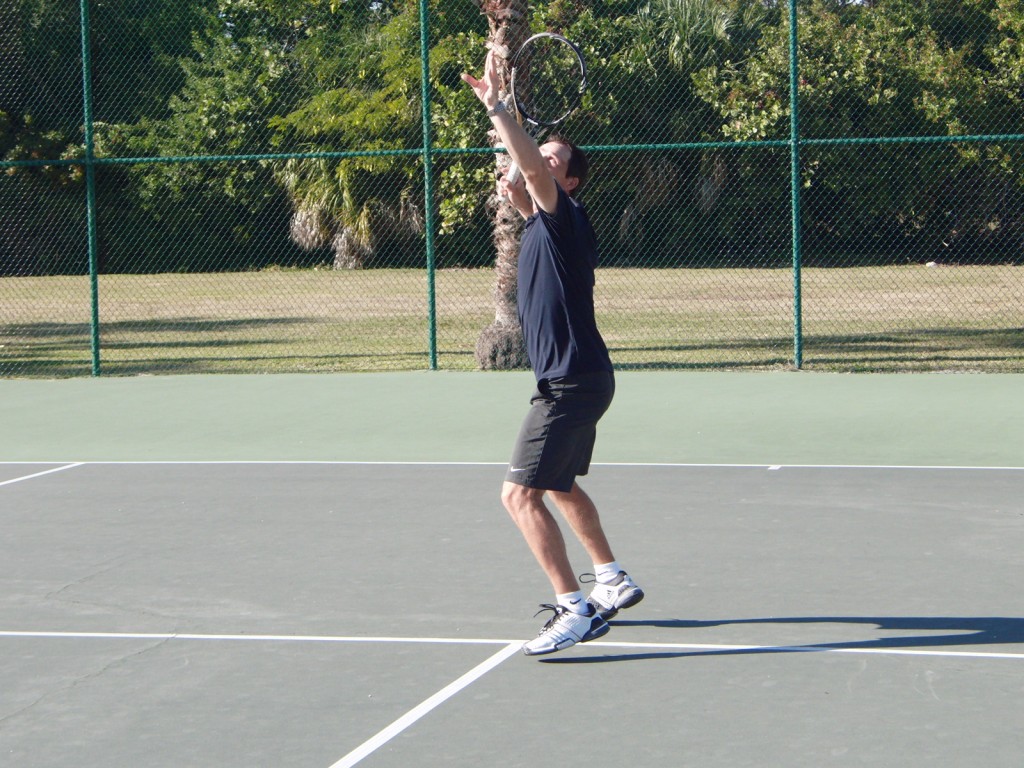
The serve is arguably the most important stroke in tennis. Not only does one have more time to execute this stroke than any other stroke but one also has two attempts to get it in. Having said that, it is equally important to use correct technique in this stroke so as to ensure efficiency and quality in movement (not to mention avoid injury).
In a study by Tubez et al, 2015 titled “A Biomechanical Analysis of Abdominal Injury in Tennis Serves; A Case Report”, the focus was on an ATP professionally ranked tennis player who had sustained an injury after serving. The goal of the study was to understand if the injury sustained could be explained by the players incorrect serving technique.
Previous studies in this area have shown that abdominal muscle disorder could be a source of potential risk for local injury in tennis (Natis et al 2012: Sanchis- Moyis et al, 2010) but it has not yet been shown that a specific serve kinematic could cause an injury to the abdominal muscles during this stroke. The aim of this study was to prove that a flaw in technique could cause an abdominal injury by way of comparing a biomechanical evaluation of the player to that of a control group.
The injured player was compared to five other professional tennis players of similar attributes in a series of measurements to examine possible differences.
Measurements consisted of a) 25 serves into the “T area” of the court
b) a 3D measurement of players movement patterns during the service motion. c) measuring maximal external rotation of the shoulder joint as well as maximal rotation of the pelvis and trunk using 3D kinematic evaluation.
d) measuring players maximal ground reaction force and impulsion using two force plates.
e) measuring passive joint mobilisation of the main joints and muscle flexibility, as well as measuring the isokinetic force generated by the hamstrings and quadriceps.
The study found that injured player had the best serving performance in racket speed compared to the mean of the group which could be significant because there is a correlation between racket velocity at impact and ball speed (Gordan and Dapnena, 2006).
The author also states that leg extension is a key parameter in the search for efficiency in the tennis serve and therefore rapid leg extension contributes to serve speed. In relation to this the injured player had a lower leg drive impulsion result. However, this was not due to a deficit of strength as isokinetic results showed better muscle quality in the injured player than that of the mean of the group.
Results showed that ankle plantar flexion bi-laterally was lower for the player than the group. Also, when leaving the force plates the player was shown to have more knee flexion bi-laterally than the control group and therefore incomplete knee extension when leaving the force plate. The author thus hypothesises that this lack of energy generation must therefore be recovered by other movements in the kinetic chain in order to obtain the best result of serve velocity.
Additionally, an anterior pelvic tilt was measured as higher for the injured player than those in the control group, which is of significance because this causes increased lumbar lordosis leading to tension on the hamstrings which the author reasons as an explanation for the players incomplete leg drive.
A maximal forward shoulder velocity was shown to be higher for the player than in the group during serve indicating a higher energy generation between pelvis and shoulder for this player highlighting a compensation between pelvis and shoulder. The author reasons that the abdominals are then working harder to transfer energy from the pelvic girdle to the shoulder girdle.
Results also showed a larger external rotation for the player than in control group which is significant in the cocking phase of the service motion as the player takes his racket back. The authors states that this action could also add increased lumbar lordosis in addition to the abdominal eccentric tension. That author hypothesises that the players lack of leg drive leads to various compensations including abdominal workload and larger external shoulder rotation.
The eccentric contraction of non-dominant rectus abdominus followed by a concentric contraction during the cocking phase of the service motion is then hypothesised as related to the injury mechanism. The anterior pelvic tilt also develops an abdominal pre-stretch during the eccentric phase of serve followed by a concentric phase of the abdominal contraction. In a previous study by Maquiriian et al, 2007 it is stated that this rapid muscle request during the start of trunk flexion can lead to tear, as could be the case here.
Regarding this study, the author admits that overuse could be one reason for injury as well as imperfect technique.The injured player was shown to have a deficit of energy transfer due to an uncompleted leg drive and a specific pelvis kinematic which led the author to propose that the player compensated. The author states that the injured player may have compensated by way of a larger abdominus contraction. These specificities could be a retrospective explanation of medical history concerning the players abdominal muscles as well as the players risk for future injury.
What must not be overlooked was that the injured players serve was faster than those in the control group despite the deficiencies outlined in the results of testing. However, as stated results indicate that the specific technique of serve has been compensated for by the injured players lack of ROM, lack of ankle plantar flexion, lack of knee extension, increased anterior pelvic tilt and increased external rotation in the shoulder.
Some practical applications can be offered in the management of players through a 3D analysis thanks to this study such as measuring ankle ROM, GHJ ROM and Knee ROM. Also, this study shows that when training athletes to prevent injury during the serve it is important to work on ROM and ensure that the kinetic chain is firing optimally.
Bjorn Blythe provided the critical review and summary of these research studies.
Knowing The Ranking Pathway To Professional Tennis
By Mark Kovacs, PhD, CTPS, MTPS
If you work with high level juniors, collegiate players or young transitional professional players this article will be valuable. If the goal of these players is to make it to the Top 100 on the ATP or WTA tours they will need to progress through a few stages of development. Below is some real-world data that can help all iTPA professionals when working with these individuals.
Making it in professional tennis is usually discussed in the terms of making it inside the Top 100 in either the ATP or WTA rankings. This is a lofty goal and most professional tennis players do not actually make it inside the Top 100. Although many very good tennis players never make this ranking milestone, (and it is certainly a very high bar) it is somewhat similar to a player who makes the NBA G-League but never makes the NBA or a minor league baseball player who never makes the Majors. These athletes are some of the best in the world, but never reached the highest pinnacles of their respective sports.
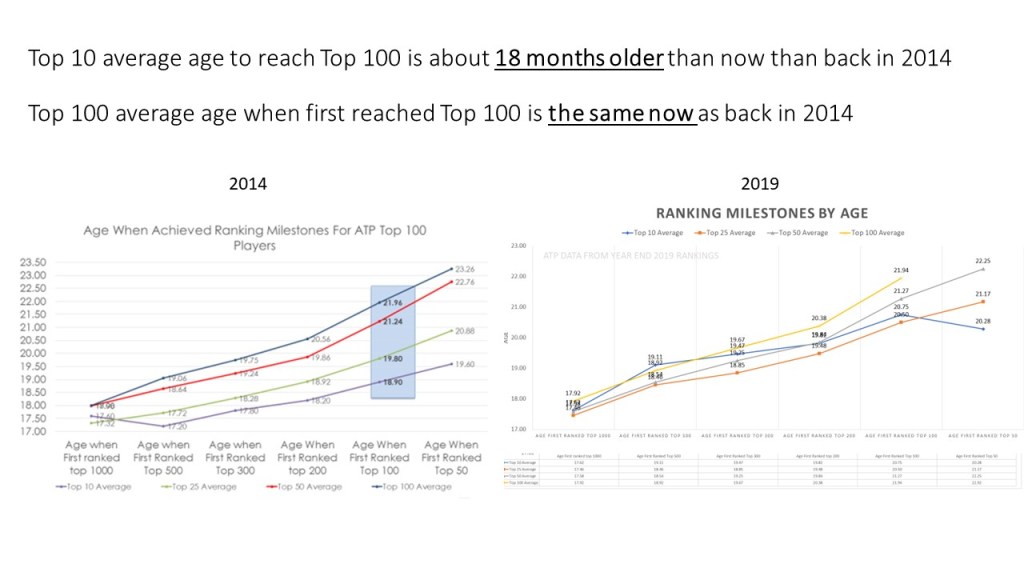
For purposes of discussion, we will focus on individuals that do reach the Top 100 in the ATP and WTA rankings as it is usually the ranking that is used as a definition of success in pro tennis. The main reason is that this is the approximate cutoff for direct entry into the four Grand Slam (main draw) tournaments and also provides direct acceptance into many of the higher level professional tournaments. If an athlete can keep the ranking inside the Top 100 that usually means they can earn a good living playing tennis.
Over the past decade I have directed a number of research studies looking at what it takes for players to make the Top 100 ranking both from a qualitative and quantitative perspective. These studies have included data collection and analysis of thousands of hours of information with over one million data points. The original quantitative analysis was performed back in 2014 and it had very specific goals of determining what the best players did to achieve a Top 10, Top 25, Top 50 and Top 100 ranking. This included analysis all tournament results, matches played, rankings earned in junior tournaments, ITF events and pro events. This included looking at which athletes were on certain pathways and which players were not on certain pathways. Predictive analytics was used to help explain which athletes were tracking to certain ranking goals. This information has been used for many different purposes whether from a federation, coaching, agent, or player perspective when determining whether to go straight to professional tennis or to attend and compete at the collegiate level.
Although many variables exist in determining whether a player will achieve a certain tennis ranking, the data obtained from these studies highlight the rather consistent pathway that most players take to a Top 10 ranking. The Top 100 ranking has more variability, but it also provides a very consistent range that players fit in during their junior careers. Although every player has a different path to the Top, the data consistently shows that we really do not have major outliers in our sport. It requires a long journey and hitting a series of measurable benchmarks throughout the junior career, transition pro career and professional career.
Below are some of the major highlights of this data. This is a very small example of some of the data and provides a nice summary of certain aspects for both male and female tennis players.
If you prefer to watch and listen to a discussion of some of the major findings, please see this webinar that Dr. Mark Kovacs did.
Listen here to a 60 minute webinar on this topic where I discuss the data on the Functional Tennis Webinar


How Many Matches Do Players Play At The ITF Junior Level
Posted in General
Leave a comment
The Importance of Hip Range of Motion in Tennis
By Patrick Aubone, CTPS & Dr. Mark Kovacs, CTPS, MTPS
Hip range of motion in tennis is one of the most challenging areas to train and treat. It is well understood the importance of the hips in the tennis player both from a movement standpoint, but also from a stroke efficiency perspective. Limitations in hip range of motion has been linked to lower back issues and also shoulder and upper extremity problems. In tennis hip range of motion is important in order to transfer energy from the lower body to the upper body through the kinetic chain. Repetitive rotational stress in the lower extremities playing tennis can lead to sport specific range of motion adaptations. Such adaptations may increase the risk of injury to other joints along the kinetic chain.
The increase risk of injury due to lack of mobility is worrisome at the recreational level. Common injuries seen include shoulder injuries, tennis and golfers elbow, abdominal pulls, groin and hamstring pulls. Some if not all of these can possibly be prevented by increasing the hips range of motion. Abdominal strains are linked to hip flexion contractures. A hip flexion contracture is caused by sitting for extended periods of time. In one study hip flexion contractures were linked to abdominal strains with iliopsoas tightness. Tight ligaments and muscles were more related to injury in men not in women in one study done on college athletes (Krivickas 1996)
Increasing range of motion is important because decreased hip strength may be associated with poor control of lower extremity motion during weight bearing activities. A lack of hip strength can lead to abnormal patellofemoral motions and pain. Individuals suffering from patellofemoral pain syndrome demonstrate significant impairments in hip strength. The question now is how can one increase their range of motion? The following exercises will help increase quadriceps and hamstring flexibility along with increasing hip range of motion.
- Figure 4 stretch – Lying flat on your back place the outside of the right foot on the left quadriceps. Next place the right hand through the triangle and grab the left shin with both hands. Next pull the left leg towards your chest as far as possible stretching the right glute.
- Single Leg Flexion – Start with one leg back with the knee downward flat on the ground while the opposite leg is flexed at 90 degrees. Make sure that your forward foot is in line with the same side hand in order to keep your shin vertical. Next place the hand on the foot locking it in place and sprawl the opposite leg back and drop move the forward knee slightly outward. From here move in and out with the front leg to loosen up the hip capsule.
- Hip External Rotation – Sit upright with your legs straight out in front of you. Set up by learning toward one side and swing the opposite leg forward perpendicular to your body. Next extend your back leg keeping the foot flat on the ground and maintaining a flat back. Slowly lower your chest towards the ground. Make sure to hold the front foot down, one you have reached your limit experiment by rotating your torso in different directions still maintaining a flat back.
Here are 10 common hip stretches that can be a valuable addition to an athletes training – http://dailyinformator.com/10-piriformis-stretches-to-help-you-get-rid-of-sciatica-hip-and-lower-back-pain/
These are just a few exercises that can help increase range of motion in the hips and help prevent injuries. Because of the rotational nature of the sport it is vital to have a healthy kinetic chain from the ground up. The hips and glutes play an important role in the entire kinetic chain and their flexibility and range of motion is very important.
Here is another great resource on stretching the hip (as well as many other body parts) in the Dynamic Stretching book and the Stretching Strap Workbook at the link http://mark-kovacs.com/products.html
Sources:
https://www.ncbi.nlm.nih.gov/pubmed/25214532
https://www.ncbi.nlm.nih.gov/pubmed/8931525
http://www.jospt.org/doi/abs/10.2519/jospt.2007.2439?code=jospt-site
Patrick Aubone CTPS, MTPS, M.S.
EXOS Phase 1 Mentorship
USPTA Lvl 1
PTR Professional
iTPA Professional Tennis Performance and Physical Preparation Expert Group
Here was our November meeting where over 50 Top physical trainers, CTPS professionals and top experts who train professional tennis players discussed the unique aspects of 2020 and also the preparation for the 2021 Australian Open and 2021 season.
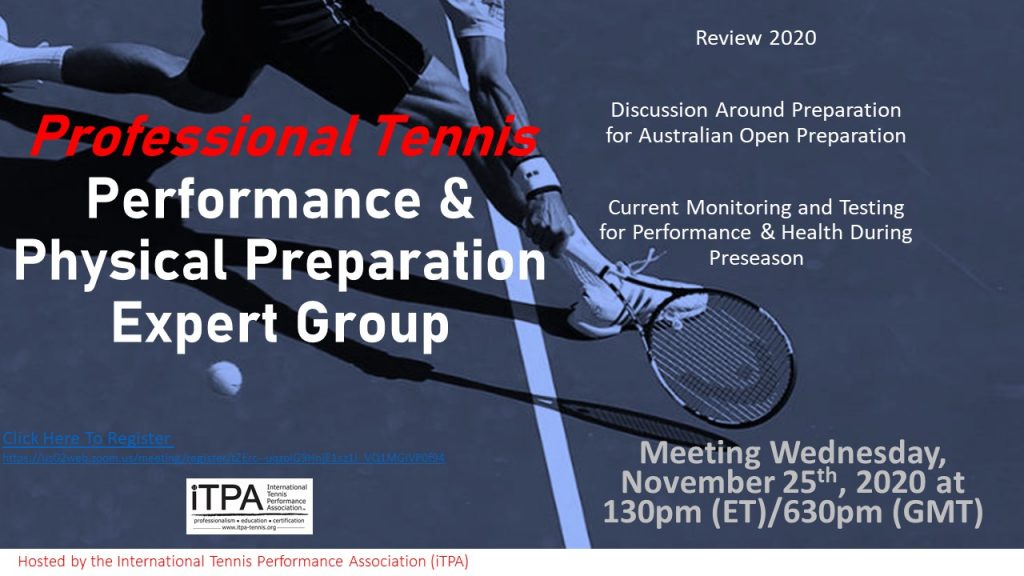
Jez Green – Physical Preparation Coach for Andy Murray and Currently Alex Zverev
Satoshi Ochi – Head Strength & Conditioning Coach for the United States Tennis Association
Gabriel Echeverria – Physical Preparation Coach for Tennis Australia
Dozens of other top coaches working with professional players
Posted in General
Leave a comment
Lateral Acceleration: Djokovic, Nadal and On-Court Training
by Doug Eng EdD PhD, MTPS and Bharathan Sundar
Tennis movement can be characterized by primarily short lateral bursts over typically 3-4 m initiated by a reactive split-step. Movement can be improved by: 1) strength-speed training, 2) technical training, 3) and anticipation training. Kovacs (2009) summarized the importance of lateral movement training. This article will address on-court lateral acceleration with regards to strength-speed and technical training. Lateral acceleration depends on unilateral movement, or specifically, the outside leg to enhance ground reaction force (GRF).
Click below to read the full pdf!
Posted in Lateral Movement, Movement, Speed & Agility, Training
Leave a comment
SLEEP AND TENNIS PERFORMANCE: A WEBINAR WITH DR. SINGH
The topic of sleep is one of the most important for all athletes. However, for tennis athletes it becomes even more important due to the uniqueness of the tennis schedule, how you may play multiple matches in a day, at different times and in different time zones. All these factors results in challenges when it comes to optimizing sleep for tennis performance. In this iTPA Webinar, we have Sleep expert Dr. Meeta Singh who provided a great overview of sleep for athletes with a focus on tennis. This webinar also included a series of questions from the live audience as well.
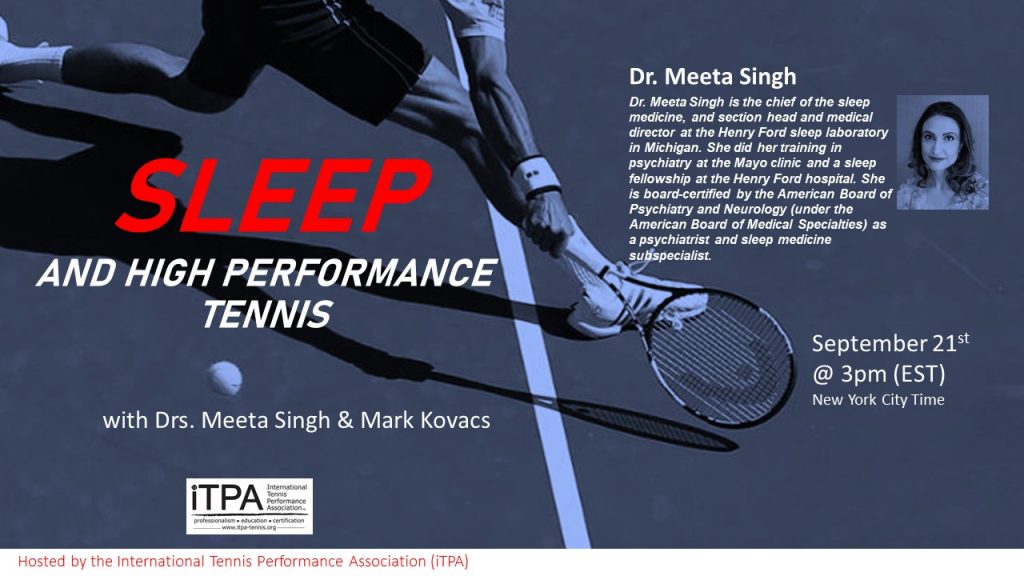
Here is the link to the hour long webinar:
Dr Meeta Singh is a sleep doctor whose work and research focuses on “Coaching the sleep muscle” to help maximize performance in both individual athletes and sports teams.
She is the chief of the sleep medicine, and section head and medical director at the Henry Ford sleep laboratory in Michigan. She did her training in psychiatry at the Mayo clinic and a sleep fellowship at the Henry Ford hospital. She is board-certified by the American Board of Psychiatry and Neurology (under the American Board of Medical Specialties) as a psychiatrist and sleep medicine subspecialist. She is a member in good standing of the American Academy of Sleep Medicine the Sleep Research Society. She has served as a consultant for multiple NFL, MLB, NHL and NBA teams. She has also worked with college sports teams. As part of this service, Dr. Singh performs athletic sleep assessments with personalized prescriptions for better sleep. She also helps sports teams and athletes with their travel management with a focus on addressing sleep deprivation and jet lag and maximizing athletic performance. Her passion is lecturing and educating teams and athletes about the benefits of sleep on performance.
Posted in Performance, Sleep
Leave a comment
RETURN TO TENNIS (RTT) MODEL FOR HIGH PERFORMANCE PLAYERS Webinar
Great 60 minute webinar on the topic of Returning To Tennis Focused On High Performance Players. In this webinar Satoshi Ochi, MA, CSCS, CTPS, MTPS and Mark Kovacs, CTPS, MTPS discuss the Return To Tennis (RTT) Model using real data of Top 100 and Top 200 WTA players and a plan to help you use this information to help better structure your Return To Tennis planning and periodization. Also in this webinar, Jonny Fraser, CTPS, MTPS provides some great insights in working with high performance junior players.
Posted in Dr. Mark Kovacs, Training, Video
Leave a comment
ARE WE MAXIMIZING THE WARM-UP TO BENEFIT THE ATHLETES?
By Johnny Parkes, USTA Senior Manager Player ID and Development, MTPS
The warm-up is the most underutilized and undervalued part of a training session. Picture the standard dynamic warm-ups and you will usually see players running a couple laps followed by some dynamic stretches with low engagement and boredom; players are monotonously trying to get through it. Some may throw in a couple sprints at the end and off they go. If the warm-ups are in the gym, you may see players cycling on a bike with their arms crossed for 5 minutes before lying around the floor, some foam rolling and most chatting with each other. No engagement, no challenge, no purpose in their preparation.
For years I have questioned the way dynamic warm-ups are delivered; what I am seeing youth athletes do does not align with what we know about principles of growth and maturation physically, cognitively, emotionally, and socially.
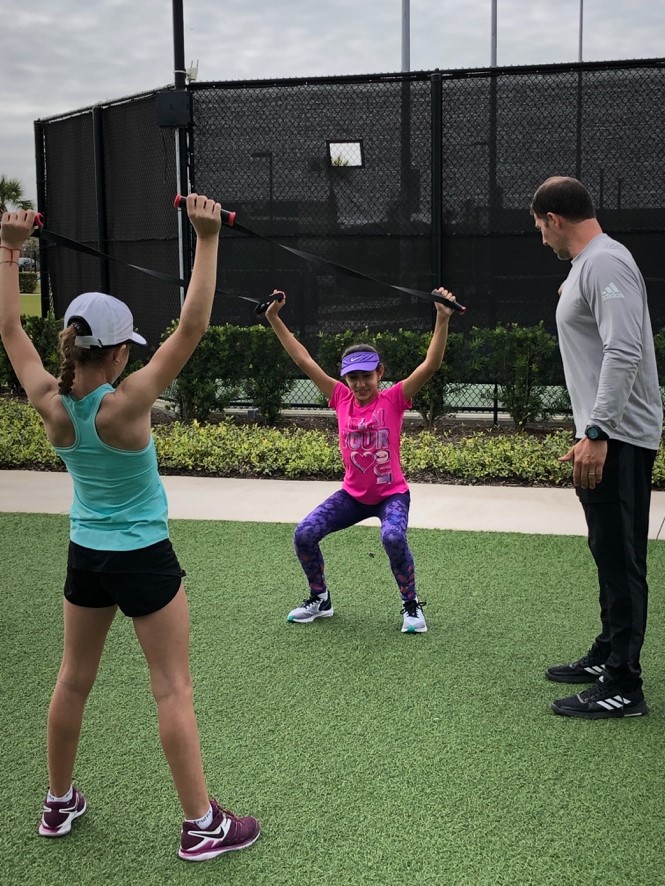
The warm-up is the best time to work on athletic development skills. It should be integrated into every training session and competitive event. If organized right, the warm-up will be a progressive plan to optimize athletic development through a blend of general movement skills and tennis-specific skills. It should be FUN.
We must re-evaluate and modify how we currently deliver warm-ups to capture the engagement of athletes to best prepare them physically AND mentally.
DEVELOPING YOUR M-V-P
Whether you have 10 minutes or 30 minutes to do a warm-up, it should be done with an MVP in mind; a Mission, Vision and Purpose.
I have detailed my M-V-P below, that has drawn inspiration from master tennis coaches, athletic development coaches such as the legendary Vern Gambetta owner of the GAIN Network, Athletic Medicine experts such as Ed Ryan, former Director of Sports Medicine USOPC, sports science/strength and conditioning experts such as Dr. Paul Lubbers and Dr. Mark Kovacs. You can develop one to fit your philosophy, wants and needs.
MISSION
Enhance Athletic Performance through a systematic, integrated and progressive approach in an environment that instills habits of daily physical and mental preparation to develop the most robust, adaptable tennis athletes possible.
VALUES
- Environment
- Teaching and Coaching
- Growth Mindset
- Relationships
- High Standards
- Commitment to Excellence
PURPOSE
Develop competent, confident athletes that meet the demands of the sport.
Once your M-V-P is established, it will provide direction for you to develop the framework informed by science and delivered with art. The warm-up can be structured according to the RAMP concept:
- Raise – designed to increase blood flow, muscle temperature and elasticity and neural activation.
- Activate – Engage muscles for the upcoming session
- Mobilize – Focus on movement patterns which will be used during the game
- Prepare (Potentiate) – Gradually increase the stress in preparation the upcoming session
AD WARM-UP FRAMEWORK:
Using this concept as a guide, I created a framework incorporating physical and mental skills to be developed every day. If you can commit 10 minutes each day to warm-up, the equates to 60 minutes over 6 days, more than most children do PE these days. If you have 30 minutes, the cumulative effect is 3 hours a week to develop fundamental and sport-specific skill with the mental skill qualities that can create robust, adaptable tennis athletes. My framework is detailed in this picture:

Movement and Mobility – During this stage replace the 3 L’s (No laps, lines or lectures), with the 3 C’s, Challenge Coordination and Competence will ensure increasing blood flow, muscle temperature AND neural activation.
- Movement – Locomotor activities such as skipping, shuffling, carioca, serpentine runs etc. Use leader/follower, proprioceptive cues to challenge neural activation.
- Mobility – 3 for 1’s. Combine several dynamic stretches together to sequence flowing from one movement to the next that will challenge movement problems with balance and stability.
Strength and Balance – Movement patterns such as squat and lunge help mobilize joints and increase movement capacity. It can be effective and efficient in providing an opportunity to individualize based on appropriate pre-habilitation and rehabilitation exercises for the athlete’s needs
Athletic Movement – As the intensity increases we can incorporate a progression of movement or skill patterns, that provide an opportunity to deliver effective speed, agility, and change of direction training that challenge decision making.
Tennis Movement Preparation:
As the warm-up come to an end, it is good to finish with an activity that challenges the athletes at full speed with the opportunity to problem solve and make decisions as the last activity they do before picking up their racquets. Depending on the objective of practice, we may choose an athletic skill that underpins the tennis skill and mimics the skill(s) about to be performed.
The attention to detail in designing the warm-up reflects a coach’s intention to develop robust, adaptable athletes from the ground up.
Our job as coaches should also be to nurture an enjoyment and love for their off-court development. The warm-up, cool-down or stand-alone athletic development session should be something for the player to look forward to. Nothing brings a coach more satisfaction than having their athletes run up to them asking to do certain activities because they are fun, dynamic and appropriate.

So, give it a go, create your M-V-P and reimagine the way in which you deliver the warm-up outside the standard dynamic warm-up. Why not create an environment where athletes maximize their enjoyment in every part of their training schedule starting with the warm-up? Use constraints, insert games, challenge creativity and you just may see a young athlete’s ability to get creative, problem solve and make decisions improve alongside their physical development, which can be accelerated at faster rates with the cumulative effect that the warm-up gives you over the course of a week, month and year.
Posted in Dynamic Warm Up, Growth & Development
Leave a comment
Functional Core Training for the Tennis Athlete
Guest Post by Josh Rifkin, MTPS, RacquetFit, USPTA, CHEK, FMS, LMT
Co-Director of Fitness and Academy Coach, The Austin Tennis Academy
Medicine ball throws, long plank holds, crunches and sit-ups. Is this type of core training for the tennis athlete flawed? These types of core training methods have been around for ages, but does that mean these methods are optimized? I would argue no. While most videos and core routines posted for tennis athletes are either extremely dynamic (medicine ball throws) or extremely static (record breaking plank holds) there is a huge link missing from this to help optimize a tennis athlete’s performance, not to mention protect their bodies from injury.
All of the following components of core training must be included for the tennis athlete:
- Anti-Rotation: Movements that resist rotation in the spine (All strokes in tennis)
- Anti-Extension: Movements that resist extension in the spine (serve focus, groundstroke posture)
- Anti-Lateral Flexion: Movements that resist lateral flexion, or side bending (all strokes in tennis)
- Static Core Stability: Resisting movement or creating “stiffness.” in the trunk. Prerequisite before powerful and dynamic core movements
- Dynamic Core Stability: Maintaining postural control and stability while under load/stress or movement in multiple planes of motion. (All situations in tennis)
- Perturbations: External Disturbances or Stimulus (like contact of a ball). Fires reflexive core stabilization
As you can see, plank holds or medicine ball drills are just beginning to scratch the surface of the core training needed to optimize the tennis athlete’s body.
I’m sure most of us are familiar with the kinetic chain, and transfer of force or energy for the tennis athlete. This concept must be addressed in core training or you risk leakage of energy, inefficiency in movement/strokes and injury. The tennis athlete is extremely dynamic, competes in multiple planes of motion, in a chaotic and uncontrolled environment. Core training must mimic these demands.
The tennis athlete must have a strong and stable foundation in which they can transfer power, repeatedly and controllably. This comes from a concept coined by renowned biomechanists Janice Moreside and Stuart McGill. This concept is “proximal stability for distal mobility.” Proximal meaning situated near the center of the body (ie, core) and distal meaning situated away from the center of the body (ie, arms/legs). Functional core training for the tennis athlete must address this concept to fill in the missing links of partial range of motion drills and prematurely executed sexy and dynamic power drills. Simply stated, the tennis athlete must train with a controlled platform (proximal) for a mobile, yet controlled and dynamic (distal) environment.
“In an efficient state the trunk provides appropriate proximal stability or controlled mobility to support optimal task or postural performance.” Basmajian, J. V. (1993). Rational manual therapies. R. Nyberg (Ed.). Williams & Wilkins.
Working with tennis athletes in these functional ways help us connect the kinetic chain while improving stability when exposed to the court.
This is one of my favorite images to show the importance of this: Taken from Paul Chek’s Scientific Core Conditioning:

This image shows how the small stabilizer or intrinsic system supports our structural integrity to allow stability when the larger prime mover muscles provide force production. Addressing core training with only dynamic movement drills and partial range reps (med ball throws and sit ups) only address the “outer unit” neglecting the “inner unit” exposing potential risk on the “mast.” On the other hand, drills that only address stiffness and stability (plank holds) without any dynamic components neglect the fact that the tennis athlete does not perform on court while stiff and braced. Back to the concept above, “proximal stability for distal mobility.” Of course there are times when all of these traditional training methods should be used and everyone should know their “why” behind programming any exercise. However, incorporating more functional movements will ensure the athlete be better equipped to handle the med ball drills and any other power movements you incorporate into your training. Not only this, it engages the athlete at a higher level due to high level of specificity for their love, tennis. No pun intended. They can connect to the “why,” and it challenges their nervous system in a way partial range mind numbing stomach hardening crunches do not. These partial range prime mover exercises also play a role in contributing to postural imbalances. These imbalances affect the structure of the “mast” and hurts efficiency of the kinetic chain.
I challenge everyone to get creative with their core training to help the tennis athlete be exposed to more specific demands they will see on the court.
Here are just 6 of many of my favorite functional core exercises you can play with (pictured at the end of this article):
- Side plank with top arm in “Y” position, performing small shoulder pulses or movements with a band
- Stance Specific Isometric holds with multi planar palloff presses/band movements
- Glute Bridge Variations with Perturbations (external disturbance or stimulus) from external force or band
- ½ kneeling or stance specific Swiss ball/med ball movements with arms (can add perturbations to ball)
- ½ Turkish get up to bridge with hold (can add perturbations to top arm or bottoms up kettle bell)
- Medicine Ball Shadow Shots with end position holds (can add perturbations to the hold)
To conclude, you must be able to resist and stabilize movement in order to produce it repeatedly with power, efficiency and safety. Following the concept of “proximal stability for distal mobility” can fill in this missing link of core training for the tennis athlete. In a functional environment the cores job is not to only produce movement, but to stabilize and resist movement as well. Functionally, core musculature will co-contract to help create stiffness and stability in order to protect the body’s joints by connecting the kinetic chain and transfer forces/energy (see types of core training listed above). Have a direct “why” in your core training.
So I’ll ask the question again… is the current core training for the tennis athlete optimized? You decide.
For more information or any questions on how to optimize core training for tennis you can reach out to Josh at:
Email: jbrifkin1@gmail.com
Cell: 2603855913
Insta: @Coach_Rif
DON’T MISS THE CORE TRAINING EXERCISES BELOW!

Posted in Core and Legs, Medicine Ball, Training
Leave a comment
Using Visualization Skills to Better Your Tennis Game During COVID-19
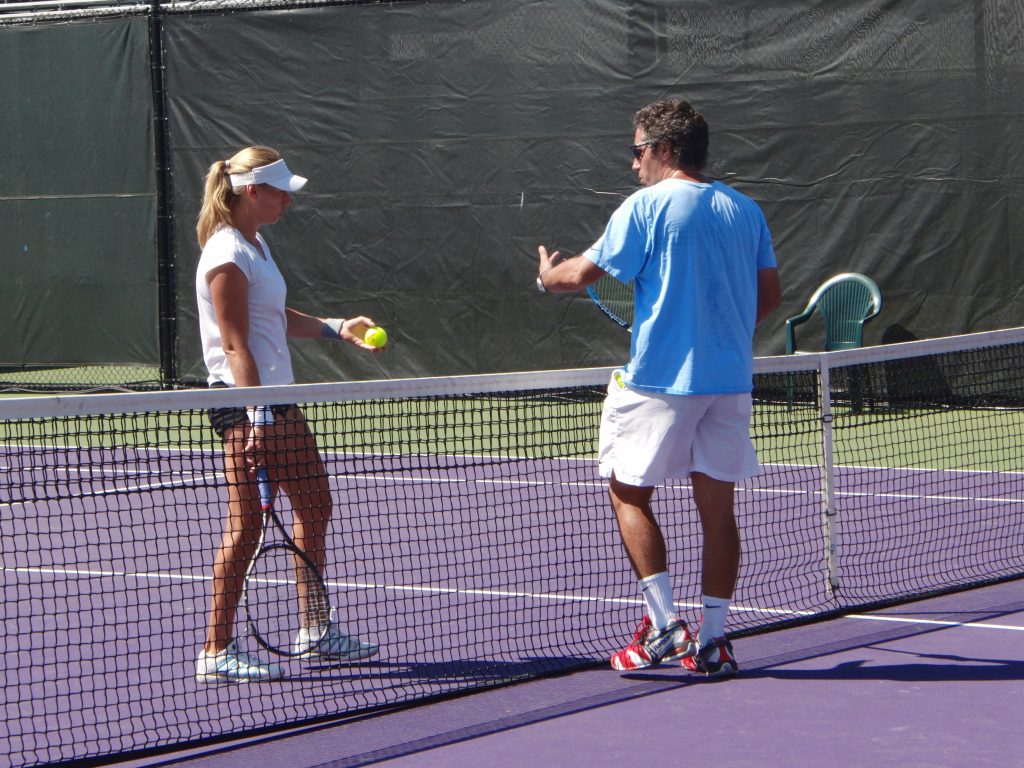
Guest post by Adam Lee, TPT, CTPS
Glen Head Racquet and Fitness
Visualization is arguably the most important factor in the mental approach to tennis, and the current situation we are facing with the COVID-19 pandemic gives us an opportunity to turn within and hone our craft through improving mental acuity with certain visualization techniques. Strong visualization skills allow players to run scenarios in their heads, getting an edge on the court through practicing meditation, imagery, and interval training off the court.
Meditation is a technique used by many athletes who want to train their mind. An athlete meditates in order to find a state of consciousness to focus on only what is necessary for that period of time with undivided attention. Current world number one and 17-time Grand Slam Champion Novak Djokovic is known throughout the tennis world for his rigorous routines and preparation, which involves meditation, diet and yoga. Meditation improves an athletes ability to focus in the zone, sharpen concentration and awareness, while releasing negative energy that could poorly impact performance.
Djokovic says that “One of the ways is to kind of meditate but not meditate with the intention of going away from those problems, but visualize,” (Wegela. 2010). Doing so, he is able to reflect upon his self and obtain the mental clarity needed to overcome any hurdles he may be facing. Meditation requires significant brain power, and many young athletes have not yet developed a sufficient degree of control and willpower to fully incorporate mediation into their program. That said, the sooner meditation is started as part of a young player’s routine, the better, as it may not have an immediate impact, but will certainly pay huge dividends on a competitive level down the line.
During COVID-19, I have spent much of my time researching and watching webinars, with one in particular being ‘Building Character and the USTA Teaching & Coaching Philosophy.’ One topic in particular discussed was how players can gain so much knowledge and confidence by using a visualization skill such as imagery. Imagery will help players absorb information through the demonstration of others. Just by watching another compete can offer you so much information, allowing the otherwise new skill to feel more familiar, translating into a more confident attitude emulated. Juniors can use imagery in their homes as a way to visualize and connect with the idea of competing. Watching others compete can give these players a better sense of what a particular skill, tactic, technique or mindset looks like which will ultimately make it easier to emulate and thus improve the quality of their own game. Patrick Mouratoglou, Serena Williams’s coach, understands the importance of watching. He believes that is one of the best ways for a player to learn.
Many pros watch each other to develop tactics and help them mentally in stressful situations such as break point down at 4 all in the 3rd set. For example, Victoria Azerenka studies Rafael Nadal for his mental strength because he is known to make a stressful situation look calm.
Lastly, another visualization skill for juniors to use during COVID-19 is the ability to use interval training to connect with competing in matches. So what exactly is interval training and how can this help players visualize themselves in a competitive match?
Interval training alternates between short and high intensity bursts of activity with a recovery in between allowing the body to train the two energy systems: aerobic and anaerobic. Briefly, aerobic exercise is any type of cardiovascular training – i.e. cardio – and the anaerobic system involves short intense burst of energy performed at maximum effort.
As any competitive player knows, tennis matches consist of short bursts high intensity points, usually lasting no more than than 10 seconds, with pauses up to 20 seconds in between points and 90 seconds at the change of ends. To simulate this sort of activity you don’t need fancy equipment, just your driveway, a nearby hill, high school track or a treadmill if you have one. You can recreate a match experience mentally by sprinting 10-15 seconds to represent point play, taking 20 second rests to signify the time between points to regroup, gather thoughts, and take deep breaths. Not only can this help you on a physical standpoint but also mentally. By the middle of the exercise, you may be exhausted but have 4 sprints remaining. This is when it is time to draw back to visualization and imagine yourself being one game away from winning a tournament after playing an excruciating 3 hour match earlier in the day. That visualization will push you to finish the intervals time and time again.
During this challenging time where so many of us are unable to continue our day to day activities, these visualization techniques provide an easily attainable way for you to improve your game and can provide a bit of peace in an otherwise stressful time. Always remember, hard work opens the doors of success, accomplishments and your dreams.
References
Wegela, K. (2010 January 19). How to Practice Mindfulness Meditation. Psychology Today. Retrieved from https://www.psychologytoday.com/blog/the-courage-be- present/201001/how-practice-mindfulness-meditation
Posted in Covid-19, Mental Skills
Leave a comment
